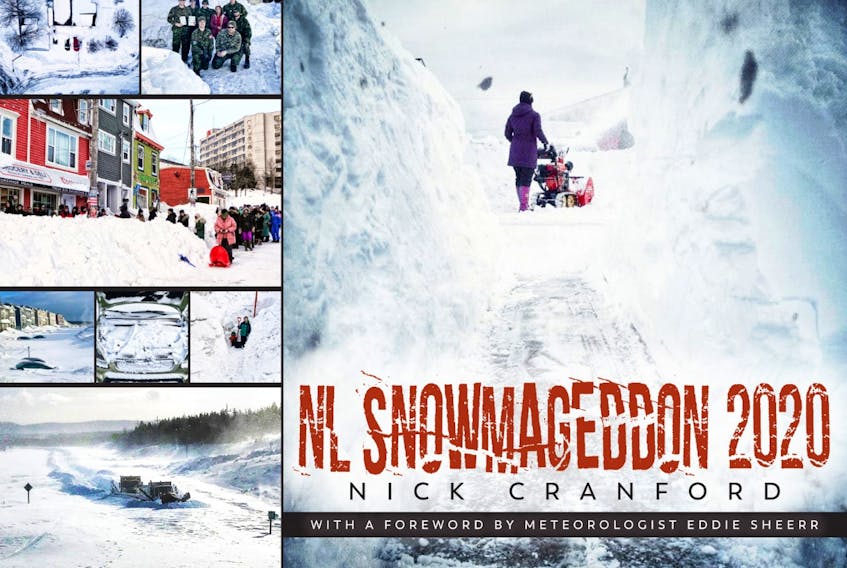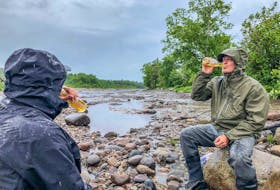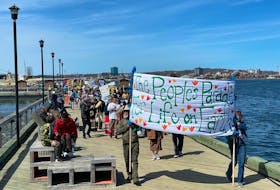It’s probably still fresh in, or possibly scarred into, your mind, but if you’re looking for a reminder or a memento of the January 17 blizzard and subsequent State of Emergency, here it is. “NL Snowmageddon 2020” is a slightly oversize, sof- cover, full-colour album of hundreds of photos, giving us a 360-degree, kinetic and panoramic view of the crisis.

Meteorologist Eddie Sheerr’s assessment of the superstorm includes that facts that it was composed of 28 consecutive hours of snowfall, of which 18 straight were in blizzard conditions; winds blasted over 100 km/h for 15 hours; and the record-breaking snowfall was 78cm in the capital, and even higher in Paradise (91cm) and Mount Pearl (93cm). (And, on a personal note, outside my downtown house it approximately a gajillion cm; we had to come out through the windows.)
“Any meteorologist gets excited when it comes to forecasting an extreme event,” Sheerr writes. “This storm was the single most intense weather event I’ve experienced. And as a meteorologist who grew up outside Philadelphia, went to University in New Hampshire (Plymouth State University), lived in Georgia and Colorado, where I experienced severe weather and mountain blizzards, and finally resided in Newfoundland and Labrador the last six years, that, too, says something.
“This storm brought me back to my childhood. I think it brought a lot of people back to their childhoods.”
It’s true that much of what transpired over mid-January was transformative.
“That day, one of the worst blizzards in this province’s history buried the eastern half of Newfoundland,” Nick Cranford writes. “A state of emergency was declared in St. John’s and lasted for eight days. The day after the storm, St. John’s was entombed. It was like a scene out of the movie ‘The Day After Tomorrow,’ in which New York City was buried in snow.”
It was cinematic. The city was completely reconfigured, the streets and houses re-sculpted by the snow. It made news on CNN and newspaper front pages from Ireland to Italy. People all over the globe followed the story, asking on social media: “But what are storm chips?”
“Mother Nature gave us one of her heaviest punches yet,” Cranford continues, “but what Mother Nature wasn’t prepared for was its kryptonite: us. Out of the depths of the white stuff, we rose. Upon reflecting on this historic event, a question continued to linger in my mind and I’m certain for many as well: what is a Newfoundlander?
“What defines us? Why were we able to handle this latest test with both grace and tenacity?” (Personal note number 2: OK, well apparently he didn’t see me when we ran out of chardonnay.) “I pondered day after day, trying to find the answer. The truth is, I couldn’t find the answer. But I realized there is no single answer. There is no one-size-fits-all description of a Newfoundlander.”
A realization perhaps reflected in the photos.
They are divided into three sections, “St. Johns Metro,” “Beyond the Overpass,” and “Have Fun Will Shovel.” Each is fronted by a painting, by Joy Hecht, Sarah Brazil, and Seth Morgan, respectively. (The volume also opens with a poster from Kyle Callahan Photography, snowflakes and rowhouses and the crisis food pyramid (beer and Lays Classic), a reminder “of the week we’ll never forget, where we all came together and helped each other out.”)
The pictures are a collective ensemble from citizens everywhere (a complete list of credits is included in the Acknowledgements), sharing snaps of their homes, driveways, and neighbourhoods.
Roof-high drifts. Front doors opened to a complete impressed block of snow. Cars just humped suggestions of themselves, big white loafs. Tunnels dug down to back doors. White crests to the tops of traffic lights.
There are also aerial, drone shots, along with landscape views of Mobile Beach or the Kelligrews walking trail, all storm surge and snowscape.
Sometimes the captions say it all: “Tracy Fowler at her parents’ house contemplating with her father, Albert, where to start.”
The Canadian Army helped disinter people. Brianne and Christopher Jordan got married in Harbour Grace, and then got back to shovelling. Levi Jacob Snow was born. People strolled, skied, dressed up like their favourite character in “Frozen,” drew hearts in the snow.
One possible gap: I could have used more of a description of the SOE itself, even a simple timeline, and contextualizing of the decisions about essential services (please see note regarding chardonnay, above.)
And perhaps more examples of the communal response? Although some flavour of that comes through the photos. (On personal note No. 3, let’s not forget the stories of hunger and loneliness we heard, and responded to. COVID-19 seems poised to deliver another such wallop. Let’s hang together, people!)
Joan Sullivan is editor of Newfoundland Quarterly magazine. She reviews both fiction and non-fiction for The Telegram.









